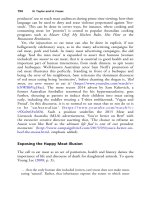The palgrave international handbook of a 457
Bạn đang xem bản rút gọn của tài liệu. Xem và tải ngay bản đầy đủ của tài liệu tại đây (31.98 KB, 1 trang )
Legal and Illegal Theriocide of Trafficked Animals
459
(when CITES came into effect) to about 1.5 million (CITES 2007). The lack
of protection for individual animals offered by CITES is a point to which I
return when discussing the fate of seized animals in Norway.
The animals who are seized may represent only the tip of the iceberg of the
number of victims who are smuggled, abducted, killed and trafficked on a
daily basis (Sollund 2013a). It is important to note that a great part of illegal
wildlife trafficking will never be detected due to the clandestine character of
the trade, and lack of priority by law enforcement agents worldwide which
entails loads of animals go under the radar.
Mortality rates are shown to be high: up to 90 % of the parrots who are
abducted die before they reach their end point (See Sollund 2015b, pp. 151–
152 for further details). Some species handle the hardship of trafficking and
captivity so badly they are referred to as ‘cut off flowers’, such as reptile
species (Herbig 2010) and slow lories who are sold off cheaply because they
die quickly in captivity (Busch et al. 2014, p. 665).
The Internet has become an important connection between buyers and
sellers, not only of animal products, but also of live animals who are traded as
pets (Lavorgna 2014, 2015; IFAW 2008; Izzo 2009). This is of concern not only
because trafficking results in species extinction, but because of the abuse (and
deaths) inherent in the trade (Busch et al. 2014; Sollund and Maher 2015).
Because birds and reptiles figure so prominently in the international literature
concerning the pet trade and in seizure reports from customs in Norway, and
are most frequently represented in my interview data also (see below), reptiles
and birds as victims of trafficking will remain the main focus of the chapter.
Norway’s Position in Relation to Pet Trafficking
of Endangered Species
Norway and Iceland are the only countries in Europe where the possession of
alien reptiles is illegal.8 Norway joined CITES in 1976 and also bans the
importation of alien ‘exotic species’ through a regulation under the Animal
8
In Norway, exceptions are made for people with allergies who, because they are unable to keep more
conventional pets such as cats, dogs and rabbits, can, upon application to the Food Safety Authority, be
granted permission to keep a tortoise. These are thus regarded as legal, while other ‘exotic’ reptile species
are regarded as illegal. There are also legal reptiles in zoos. It is open to debate whether human and
nonhuman animals may be legal or illegal, for example, migration researchers will rather refer to migrants
without the required documents as irregular than as illegal, as they claim humans cannot be illegal. The
same should apply to nonhumans. Can anybody’s life be legal or illegal, or is the animal rather forcefully
misplaced? Is s/he only misplaced if this takes place by force as in the case of human and animal trafficking?









